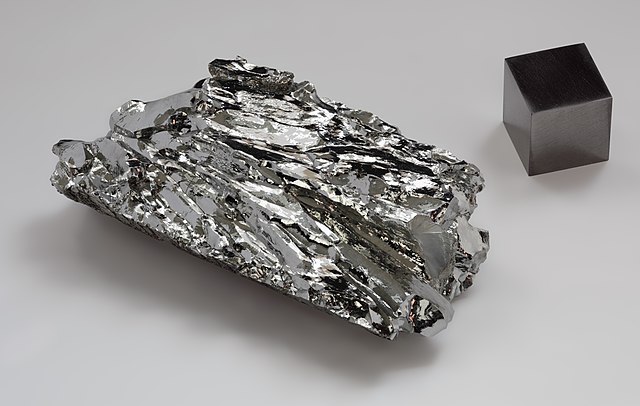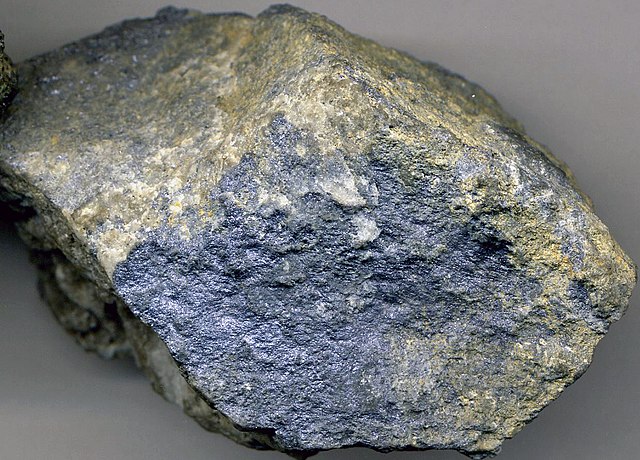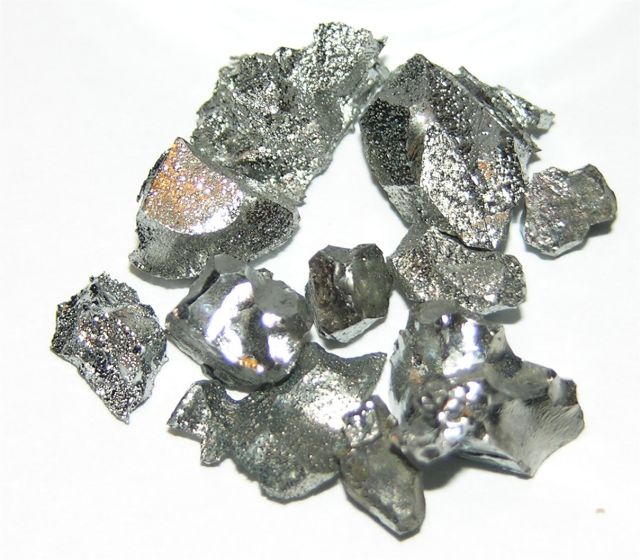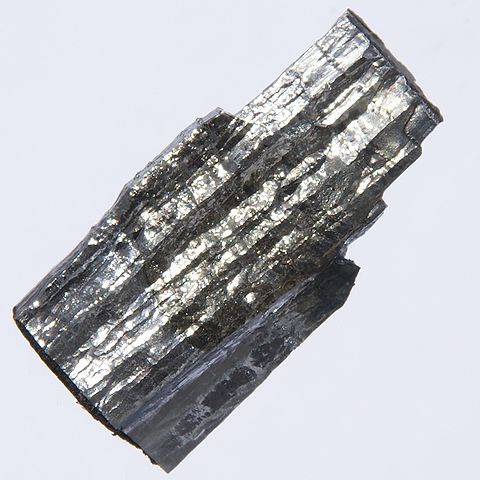Molybdenum is a chemical element with the symbol Mo and atomic number 42. It is a silvery-white transition metal that has been used in various industries since ancient times.
Molybdenum is one of the few elements that have both industrial and essential uses in human health and nutrition.
Molybdenum is classified as a member of the group 6 transition metals, which also includes chromium, tungsten, and manganese. It ranks as one of the moderately abundant elements in the Earth's crust.
The element is found in many minerals but is most commonly obtained from molybdenite, a mineral of molybdenum sulfide.
Introduction
Molybdenum has a relatively low melting point of 2617°C and a boiling point of 5560°C. It is a dense metal with a density of 10.2 g/cm3. It is also a relatively good conductor of electricity and heat, and it can form alloys with many other metals.
The chemical properties of molybdenum are quite unique. The element has the ability to absorb and form complexes with other elements and molecules, and it can act as a catalyst in certain chemical reactions. It can also form oxides and alloys with other metals, as well as form compounds with oxygen and nitrogen.

Molybdenum
The element has been used for thousands of years by various civilizations. Ancient Greeks used molybdenum to temper their steel, and the Romans used it to strengthen their armor and weapons.
In more modern times, molybdenum has found a variety of industrial uses, from its use in machinery to its use in aerospace engineering.
Molybdenum's importance to human health and nutrition has been known for centuries. It is an essential trace element that plays a vital role in human health, and deficiencies in molybdenum have been linked to a variety of health problems.
The element can be found in a variety of dietary sources, including leafy green vegetables, legumes, nuts and seeds.
This article will explore the properties and uses of molybdenum in detail. We will look at the element's chemical properties, its occurrence in nature, its role in human health and nutrition, its industrial uses, and its environmental effects.
We will also provide a summary of key points and our final thoughts on molybdenum.
Chemical Properties of Molybdenum
Molybdenum is a rare transition metal that is often found alongside other rare metals such as tungsten and chromium. It is an element with the atomic number 42, and is represented in the periodic table as Mo. Its atomic mass is 95.95 amu, and it is classified as a transition metal.
Molybdenum is known for its high melting point of 2,623°C and boiling point of 4,630°C, making it a valuable metal for industrial and commercial purposes. It has a density of 10.2 g/cm3 which makes it heavier than other metals, but still light enough to be manipulated easily.
Molybdenum has a crystal lattice structure that is hexagonal and close-packed in which its atoms are arranged in a 6-sided honeycomb pattern. This structure gives it strong binding capabilities and makes it difficult to corrode or degrade.
It is also malleable, ductile, and has a high tensile strength, making it ideal for use in machinery and industrial alloys.
The metallic element occurs primarily in sulfide ores, although it can also be found in ores containing molybdenum compounds. It is naturally found in many areas around the world, including the United States, Chile, Russia, Canada, and Australia.
Molybdenum is often used as an alloying agent in steels and other metals because it increases the hardness and lifetime of the metal while reducing its melting point. It is also used in the production of electronics, batteries, and nuclear reactors due to its high electrical conductivity and thermal conductivity.
Molybdenum is essential for human life, playing an important role in many body processes and enzyme reactions. It is found in trace amounts in certain foods such as nuts, legumes, and grains. It is also found in certain meats and is naturally produced in the gut of humans and animals.
In conclusion, Molybdenum is a valuable rare metal with many practical and industrial applications. It has a high melting point, a density of 10.2 g/cm3, and a crystal lattice structure that provides strong binding capabilities.
It is an essential element for human life, playing an important role in many body processes and enzyme reactions. It is found in trace amounts in certain foods and is naturally produced in the gut of humans and animals.
It is also an important alloying agent in steels and other metals, and is used in the production of electronics, batteries, and nuclear reactors due to its high electrical conductivity and thermal conductivity.
The Element in Nature
Molybdenum is a naturally occurring element and it is found widely distributed in the Earth's crust. While it is not abundant, it is more common than other elements like gold or platinum. It is a metal, and it is usually found in combination with other elements. Molybdenum is found as an oxide, sulfide, or silicate in various minerals.
When looking for Molybdenum in nature, one of the most common sources is molybdenite, which is a mineral composed mostly of molybdenum disulfide. This mineral is found in sedimentary and metamorphic rocks, particularly in areas where there has been magmatic-hydrothermal activity.
Molybdenum can also be found in other minerals such as wulfenite, powellite, and molybdite.
Molybdenum also has a geologic distribution that is distinct from other elements. It is most highly concentrated in the continental crust, with the highest concentrations typically found at mid-ocean ridges.

It is also abundant in some oceanic basalt and sediments, as well as in some continental basalt and sedimentary rocks.
In addition to its geologic distribution, Molybdenum is also found in different forms in different parts of the world. For example, it is found as an oxide in some areas, while in others it may be found as a sulfide. It is also found in a variety of different combinations with other elements, depending on the geologic environment in which it is found.
The abundance of Molybdenum in the environment also varies depending on the chemical and physical conditions in which it is found. Generally, it is more common in areas with a high pH level and a low temperature, such as in the oceans and in the Arctic. It is also more abundant in areas with higher levels of precipitation.
Overall, Molybdenum is a common element and is widely distributed in the environment. It is found in a variety of different minerals and in a variety of different geologic environments.
Its abundance in the environment is dependent on the chemical and physical conditions of its environment.
Molybdenum in Human Health and Nutrition
Molybdenum is an essential trace element for humans, playing an important role in human health and nutrition. It is an essential component of several important enzymes which are involved in cell functions and energy metabolism. Without enough molybdenum in the body, these processes cannot take place, leading to a range of health problems.
What role does it play in human health? Molybdenum plays a vital role in the functioning of a wide variety of enzymes, including xanthine oxidase, which is involved in breaking down purines, and sulfite oxidase, which is involved in breaking down the breakdown products of sulfur-containing amino acids. It also plays a role in transferring electrons in the mitochondria, assisting in the production of energy in the form of ATP.
Molybdenum is also important in the detoxification of sulfites, which are produced during the metabolism of sulfur-containing amino acids. It has been suggested that molybdenum helps in the breakdown of mercury and other heavy metals, and that it may be related to the prevention of some forms of cancer, although the evidence is inconclusive.
Sources of dietary molybdenum include many common foods, such as legumes, nuts, and grains. It is also found in tea, coffee, and chocolate. The daily recommended intake of molybdenum is 45 mcg per day for adults, and it is generally considered safe when consumed in amounts within this range.
Molybdenum deficiencies are rare, but they can occur in people with malabsorption disorders or with certain chronic medical conditions. Symptoms of molybdenum deficiency include anemia, growth retardation, and neurological problems. People who are at risk of deficiency should talk to their healthcare provider about supplementing with molybdenum, which is available in many forms, including tablets, capsules, and liquid solutions.
Overall, molybdenum plays a key role in human health and nutrition. It serves as an essential component of several important enzymes and helps to break down purines and sulfites. It also helps in the detoxification of metals and may be related to the prevention of certain types of cancer.
Molybdenum is found in a variety of foods, and deficiencies are rare, but people who are at risk should talk to their healthcare provider about supplementing with molybdenum.
Industrial Uses of Molybdenum
Molybdenum is an incredibly versatile element with many industrial uses, particularly in machinery, alloys, and aerospace. Due to its high melting point and low thermal expansion rate, it is an ideal material for high-temperature applications.
In its purest form, molybdenum is a silvery-white metal that is malleable and easily machined.
Uses in Machinery
Molybdenum is used in many different types of machinery. It is especially popular in automotive and aviation applications due to its strength and durability. It is often used to create valve seats and valve guides, as well as to form components of high-pressure pumps.
Molybdenum is also a key component in making precision tools, such as drill bits, lathe tools, and milling cutters.
Uses in Industrial Alloys
Molybdenum is also used in industrial alloys. It is a key component in stainless steel and other corrosion-resistant alloys. It is used in alloys to increase strength and reduce the risk of corrosion in a variety of applications.
Molybdenum is often added to copper alloys to increase their strength and resistance to corrosion. It is also used in iron alloys to reduce the risk of brittleness.
Uses in Aerospace
In the aerospace industry, molybdenum is used to create components that can withstand high temperatures and extreme pressures. Molybdenum is often added to titanium alloys to create a stronger and more heat-resistant material. It is also used in the manufacturing of aircraft turbine blades and jet engines, as well as spacecraft components.
Molybdenum is a key component in the production of many industrial products. It is used in a variety of applications to improve performance and durability. Its high melting point and low thermal expansion rate make it ideal for use in high-temperature applications.
Its strength and corrosion resistance also makes it well-suited for use in many types of alloys. Its versatility and durability make molybdenum an important element in the modern world.
Environmental Effects of Molybdenum
Molybdenum is the chemical element with atomic number 42 on the periodic table, and it has been known to have a number of industrial and environmental effects. The effects of molybdenum on the environment are both positive and negative, depending on the level of presence in the environment, as well as the use of the element.
Molybdenum, with its unique properties, can be used in a number of industrial processes, especially in the production and refining of metals. The element is also used in the production of sulfuric acid, which is a key component in the manufacturing of many products.
As a result, molybdenum can contribute to air pollution, water pollution, and soil contamination.
The presence of molybdenum in the environment can also affect the health of those who come into contact with it. In humans, molybdenum exposure can cause various health problems, such as nausea, headaches, dizziness, and a general feeling of malaise.

Long-term exposure to molybdenum can lead to an increased risk of cancer, reproductive issues, and other serious illnesses.
Molybdenum can also have a negative effect on plants and animals. The element has been found to be toxic to some species of aquatic life, and it can also reduce the growth of certain plants.
In addition, molybdenum can also cause the accumulation of other toxins in the environment, such as lead and cadmium.
The use of molybdenum in industrial processes is regulated in many countries, and the levels of molybdenum allowed in the environment are limited.
In addition, some countries have implemented rules and regulations on the use of molybdenum in order to protect the environment from the potential negative effects of the element.
Molybdenum is also used in some medical applications, and it can be used to prevent certain types of cancers and help treat other diseases. It has also been found to have antioxidant properties, which can help protect against certain types of diseases.
Although there is still much to learn about the effects of molybdenum on the environment, it is clear that it can have both positive and negative impacts.
In conclusion, molybdenum plays an important role in the environment, both in terms of industrial uses and its potential for environmental contamination. It is important for individuals and industries to understand the potential impacts of molybdenum on the environment, and to take necessary steps to minimize its impacts.
With careful management and research, we can ensure that molybdenum is used safely and effectively for the benefit of all.
Facts
Molybdenum is a chemical element with the symbol Mo
It has the atomic number 42
It is located in period 5 and group 6
The name is from Neo-Latin molybdaenum, which is based on Ancient Greek molybdos
The metal was first isolated in 1781 by Peter Jacob Hjelm
Molybdenum does not occur naturally as a free metal on Earth
There are 35 known isotopes of molybdenum, ranging in atomic mass from 83 to 117
Seven isotopes occur naturally, with atomic masses of 92, 94, 95, 96, 97, 98, and 100
Molybdenum-98 is the most abundant isotope, comprising 24.14% of all molybdenum
The free element, a silvery metal with a grey cast, has the sixth-highest melting point of any element.
During World War I, it was used both in armor plating and as a substitute for tungsten in high-speed steels.
Molybdenum is the 58th most abundant element in the Earth's crust with an average of 1.5 parts per million
Molybdenum is the 25th most abundant element in the ocean
It is the 42nd most abundant element in the Universe
The world's production of molybdenum was 250,000 tonnes in 2011

the largest producers being China, the United States, Chile, Peru and Mexico
The total reserves are estimated at 10 million tonnes
86% of molybdenum produced is used in metallurgy, with the rest used in chemical application
Molybdenum can withstand extreme temperatures without significantly expanding or softening
Molybdenum is also valued in steel alloys for its high corrosion resistance and weldability
Molybdenum had a value of approximately $30,000 per tonne as of August 2009
Molybdenum powder is used as a fertilizer for some plants, such as cauliflower
Molybdenum is an essential element in most organisms
At least 50 molybdenum-containing enzymes have been identified, mostly in bacteria
Molybdenum is an essential trace dietary element
The human body contains about 0.07 mg of molybdenum per kilogram of body weight
Molybdenum is also present within human tooth enamel and may help prevent its decay
Pork, lamb, and beef liver each have approximately 1.5 parts per million of molybdenum.
Other significant dietary sources include green beans, eggs, sunflower seeds, wheat flour, lentils, cucumbers, and cereal grain
Chronic exposure to 60 to 600 mg/m3 can cause symptoms including fatigue, headaches and joint pains.
At levels of 5000 mg/m3, molybdenum is immediately dangerous to life and health.
The Russian Luna 24 mission also discovered samples of molybdenum on the moon.
Information
| Molybdenum | ||||||||||||||||||||||||||||||||||||||||||||||||||||||||||
|---|---|---|---|---|---|---|---|---|---|---|---|---|---|---|---|---|---|---|---|---|---|---|---|---|---|---|---|---|---|---|---|---|---|---|---|---|---|---|---|---|---|---|---|---|---|---|---|---|---|---|---|---|---|---|---|---|---|---|
| Pronunciation | mə-LIB-də-nəm | |||||||||||||||||||||||||||||||||||||||||||||||||||||||||
| Appearance | gray metallic | |||||||||||||||||||||||||||||||||||||||||||||||||||||||||
| Standard atomic weight Ar°(Mo) | ||||||||||||||||||||||||||||||||||||||||||||||||||||||||||
|
||||||||||||||||||||||||||||||||||||||||||||||||||||||||||
| Molybdenum in the periodic table | ||||||||||||||||||||||||||||||||||||||||||||||||||||||||||
| Atomic number (Z) | 42 | |||||||||||||||||||||||||||||||||||||||||||||||||||||||||
| Group | group 6 | |||||||||||||||||||||||||||||||||||||||||||||||||||||||||
| Period | period 5 | |||||||||||||||||||||||||||||||||||||||||||||||||||||||||
| Block | d-block | |||||||||||||||||||||||||||||||||||||||||||||||||||||||||
| Electron configuration | [Kr] 4d5 5s1 | |||||||||||||||||||||||||||||||||||||||||||||||||||||||||
| Electrons per shell | 2, 8, 18, 13, 1 | |||||||||||||||||||||||||||||||||||||||||||||||||||||||||
| Physical properties | ||||||||||||||||||||||||||||||||||||||||||||||||||||||||||
| Phase at STP | solid | |||||||||||||||||||||||||||||||||||||||||||||||||||||||||
| Melting point | 2896 K (2623 °C, 4753 °F) | |||||||||||||||||||||||||||||||||||||||||||||||||||||||||
| Boiling point | 4912 K (4639 °C, 8382 °F) | |||||||||||||||||||||||||||||||||||||||||||||||||||||||||
| Density (near r.t.) | 10.28 g/cm3 | |||||||||||||||||||||||||||||||||||||||||||||||||||||||||
| when liquid (at m.p.) | 9.33 g/cm3 | |||||||||||||||||||||||||||||||||||||||||||||||||||||||||
| Heat of fusion | 37.48 kJ/mol | |||||||||||||||||||||||||||||||||||||||||||||||||||||||||
| Heat of vaporization | 598 kJ/mol | |||||||||||||||||||||||||||||||||||||||||||||||||||||||||
| Molar heat capacity | 24.06 J/(mol·K) | |||||||||||||||||||||||||||||||||||||||||||||||||||||||||
Vapor pressure
|
||||||||||||||||||||||||||||||||||||||||||||||||||||||||||
| Atomic properties | ||||||||||||||||||||||||||||||||||||||||||||||||||||||||||
| Oxidation states | −4, −2, −1, 0, +1,[2] +2, +3, +4, +5, +6 (a strongly acidic oxide) | |||||||||||||||||||||||||||||||||||||||||||||||||||||||||
| Electronegativity | Pauling scale: 2.16 | |||||||||||||||||||||||||||||||||||||||||||||||||||||||||
| Ionization energies |
|
|||||||||||||||||||||||||||||||||||||||||||||||||||||||||
| Atomic radius | empirical: 139 pm | |||||||||||||||||||||||||||||||||||||||||||||||||||||||||
| Covalent radius | 154±5 pm | |||||||||||||||||||||||||||||||||||||||||||||||||||||||||
| Other properties | ||||||||||||||||||||||||||||||||||||||||||||||||||||||||||
| Natural occurrence | primordial | |||||||||||||||||||||||||||||||||||||||||||||||||||||||||
| Crystal structure | body-centered cubic (bcc) | |||||||||||||||||||||||||||||||||||||||||||||||||||||||||
| Speed of sound thin rod | 5400 m/s (at r.t.) | |||||||||||||||||||||||||||||||||||||||||||||||||||||||||
| Thermal expansion | 4.8 µm/(m⋅K) (at 25 °C) | |||||||||||||||||||||||||||||||||||||||||||||||||||||||||
| Thermal conductivity | 138 W/(m⋅K) | |||||||||||||||||||||||||||||||||||||||||||||||||||||||||
| Thermal diffusivity | 54.3 mm2/s (at 300 K) | |||||||||||||||||||||||||||||||||||||||||||||||||||||||||
| Electrical resistivity | 53.4 nΩ⋅m (at 20 °C) | |||||||||||||||||||||||||||||||||||||||||||||||||||||||||
| Magnetic ordering | paramagnetic | |||||||||||||||||||||||||||||||||||||||||||||||||||||||||
| Molar magnetic susceptibility | +89.0×10−6 cm3/mol (298 K) | |||||||||||||||||||||||||||||||||||||||||||||||||||||||||
| Young's modulus | 329 GPa | |||||||||||||||||||||||||||||||||||||||||||||||||||||||||
| Shear modulus | 126 GPa | |||||||||||||||||||||||||||||||||||||||||||||||||||||||||
| Bulk modulus | 230 GPa | |||||||||||||||||||||||||||||||||||||||||||||||||||||||||
| Poisson ratio | 0.31 | |||||||||||||||||||||||||||||||||||||||||||||||||||||||||
| Mohs hardness | 5.5 | |||||||||||||||||||||||||||||||||||||||||||||||||||||||||
| Vickers hardness | 1400–2740 MPa | |||||||||||||||||||||||||||||||||||||||||||||||||||||||||
| Brinell hardness | 1370–2500 MPa | |||||||||||||||||||||||||||||||||||||||||||||||||||||||||
| CAS Number | 7439-98-7 | |||||||||||||||||||||||||||||||||||||||||||||||||||||||||
| History | ||||||||||||||||||||||||||||||||||||||||||||||||||||||||||
| Discovery | Carl Wilhelm Scheele (1778) | |||||||||||||||||||||||||||||||||||||||||||||||||||||||||
| First isolation | Peter Jacob Hjelm (1781) | |||||||||||||||||||||||||||||||||||||||||||||||||||||||||
|
||||||||||||||||||||||||||||||||||||||||||||||||||||||||||
